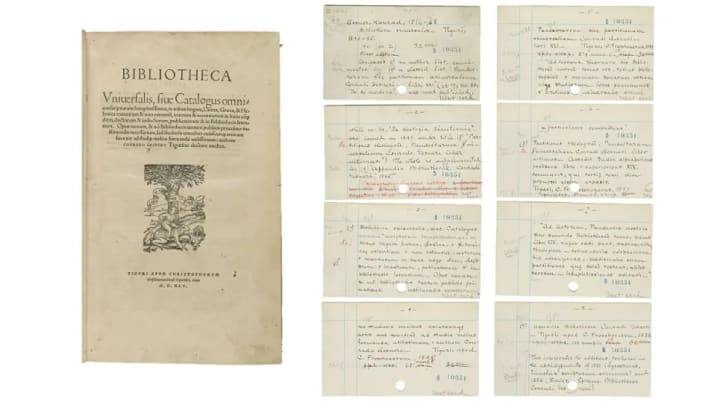With 162 million items—including more than 38 million books—the Library of Congress is the largest library in the world. Its incredible collections are celebrated in the new bookThe Card Catalog: Books, Cards, and Literary Treasures. "Flipping through the well-worn cards, many handwritten and filled with marginalia containing valuable information not to be found in an Internet search, leaves one with a sense of awe at how catalogers distilled so much information onto simple 3-by-5-inch index cards," Peter Devereaux, writer-editor at the Library of Congress, writes in the book's introduction. In honor of National Library Week (April 9 - 15), here are just a few of the cards from the Library of Congress's card catalog—which, though it has been replaced by a computer catalog, can still be found at the LOC—as seen inThe Card Catalog.
1. BIBLIOTHECA UNIVERSALIS (1545-1555) // CONRAD GESSNER

This tome was the first of its kind: a bibliography that listed 1800 authors and their works alphabetically, along with annotations and evaluations. Describing the contents of this edition of Gessner's book required eight index cards.
2. FIRST FOLIO (1623) // WILLIAM SHAKESPEARE

The Library of Congress is home to two First Folios (which are technically called Mr. William Shakespeares Comedies, Histories & Tragedies: Published according to the True Originall Copies), which has been called "the most intrinsically valuable book in English." The neighboring Folger library has an incredible 82 First Folios. Scholars believe that 750 First Folios were printed, of which 235 survive.
3. POOR RICHARD IMPROVED: BEING AN ALMANACK … FOR THE YEAR OF OUR LORD 1758 // BENJAMIN FRANKLIN

Future Founding Father Ben Franklin began publishing his Poor Richard's Almanack in 1732 under the name Richard Saunders, and kept at it for the next 25 years. "I endeavor'd to make it both entertaining and useful," Franklin wrote in his autobiography, "and it accordingly came to be in such Demand that I reap'd considerable Profit from it … I consider'd it as a proper Vehicle for conveying Instruction among the common People, who bought scarcely any other books."
4. A VINDICATION OF THE RIGHTS OF WOMEN … (1792) // MARY WOLLSTONECRAFT

In this book, writer, philosopher, and mother to Mary Shelley, Mary Wollstonecraft made an early argument for feminism. According to The Card Catalog—which says that Vindication is "considered a literary cornerstone in the struggle for women's rights"—Wollstonecraft "clearly stated the need for raising the status of women and inspired women on both sides of the Atlantic to action." Aaron Burr was an admirer; he and his wife Theodosia hung Wollstonecraft's portrait above their mantle, and in 1793, the future VP called Vindication "a work of genius."
5. A GRAMMATICAL INSTITUTE OF THE ENGLISH LANGUAGE … (1784) // NOAH WEBSTER

Pre-Revolution, people learned grammar using British primers that were based on Latin rules. Webster wanted to change that, and he started with A Grammatical Institute of The English Language, followed by American Dictionary of the English Language (1823). As Arika Okrent explained in a piece for mental_floss, "Some of his suggestions stuck—we replaced Ouisconsin with Wisconsin, colour with color, and musick with music. But his grammar suggestions fared less well … [H]is dictionary was attacked as vulgar and degenerate." His dictionary survives today as Merriam-Webster, and, as Okrent notes, some of Webster's suggestions have become standard.
6. THE BIRDS OF AMERICA; FROM THE ORIGINAL DRAWINGS (1827-1838) // JOHN JAMES AUDUBON

Audubon distributed his Birds of America on a subscription basis, sending out five hand-colored plates each month on double-elephant folio paper. Subscribers could do what they chose with the plates; many bound them into books. John Silva Meehan, librarian in 1851, noted that the book was "one of the best" examples of Birds of America, "it having been selected for us by Mr. Audubon and bound in the most substantial manner under his own care and supervision."
7. UNCLE TOM'S CABIN (1852 ) // HARRIET BEECHER STOWE

The abolitionist newspaper The New Era paid Stowe $300 for 43 chapters of Uncle Tom's Cabin, which was published in serial form in 1851 and 1852. When the two-volume book was released, it sold 10,000 copies stateswide in its first week, and 300,000 in a year.
8. HARRY HOUDINI'S PERSONAL COLLECTION

Magician, escape artist, and debunker Houdini bequeathed 3988 volumes from his library to the Library of Congress. In addition to posters and photos, the collection includes books like Artifice, Ruse, and Subterfuge at the Card Table: A Treatise on the Science and Art of Manipulating Cards by S.W. Erdnase; Indian Palmistry by Mrs. J.B. Dale; and Bright-Wits, Prince of Mogador by Burren Loughlin.
9. NEW HAMPSHIRE (1923) // ROBERT FROST

Only 350 copies of this edition of New Hampshire—which won the Pulitzer Prize in 1923—were printed. This copy, No. 187, was signed by the author.
10. THEIR EYES WERE WATCHING GOD (1937) // ZORA NEALE HURSTON

Hurston's most famous work was written during an anthropological trip to Haiti to study voodoo.
11. THE CATCHER IN THE RYE (1951) // J.D. SALINGER

In 1949, Salinger submitted a story called "The Ocean Full of Bowling Balls"—about the death of Rye protagonist Holden Caufield's older brother—to Harper's Bazaar, but withdrew it before it could be published. The story was then donated to Princeton on the condition that it be withheld from publication until 2060. It leaked online in 2013, along with two other unpublished Salinger stories.
12. IN COLD BLOOD (1965) // TRUMAN CAPOTE

The inmate case records of Perry Edward Smith and Richard Eugene Hickock—the murderers of the Clutter family, whose crime was featured in Capote's In Cold Blood—were released by The Kansas City Historical Society in 2013. Capote visited and interviewed the killers many times, but he wasn't the only person Hickock granted an interview to: He also spoke to Mack Nations for an article that appeared in the 1961 issue of Male magazine.

The Card Catalog is available now.
